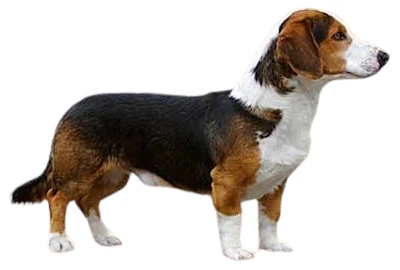
The Drever is a medium-sized hunting dog originating from Sweden, known for its endurance and ability to hunt game in challenging terrains. Primarily used for deer hunting and other hoofed animals, the Drever is also appreciated as a companion dog for its affectionate and balanced temperament.
The Drever has an elongated, muscular, and well-proportioned body, with a straight back and short yet sturdy limbs. Its head is relatively broad with a slightly domed skull. The muzzle is strong and straight, and the ears are of medium length, hanging close to the head. Its eyes, medium in size, are typically dark and reflect great intelligence and alertness. The Drever has a powerful and agile appearance despite its short legs.
Males generally measure between 32 and 38 cm at the withers, while females measure between 30 and 36 cm. The average weight of the Drever ranges from 14 to 16 kg, depending on the dog's gender and physical condition.
The Drever's coat is short, dense, and smooth, providing good protection against the elements. The coat colors vary, often consisting of combinations of white with black, brown, or fawn markings. The Drever requires moderate grooming, with regular brushing to maintain the condition of its coat and remove dead hair.
The Drever is known for its calm, friendly, and balanced nature. It is particularly attached to its family and is affectionate with children. As a hunting dog, it is highly independent, persistent, and possesses an excellent sense of smell. While it is a tenacious hunter, it is also gentle and sociable in a home environment. It may be reserved with strangers but is generally not aggressive. Its strong will and intelligence require firm and consistent training from an early age.
The Drever is a sturdy breed with an average lifespan of about 12 to 15 years. However, due to its short legs and elongated body, it may be prone to back problems, particularly disc herniation. It is important to monitor its weight to avoid overloading its spine. Regular veterinary check-ups, a balanced diet, and moderate exercise are essential to maintain the Drever's overall health.

The Drever Puppy is a versatile hunting dog breed, especially popular in Sweden, where it is valued for its exceptional tracking and trailing abilities. Medium-sized with an elongated body and short legs, the Drever is very agile and resilient, making it an excellent companion for hunting small game such as hares and foxes. This dog is also social, loyal, and affectionate, adapting well to family life. With a balanced temperament and strong perseverance, it requires firm but kind training to channel its energy.
The price of a Drever Puppy generally ranges from 700 to 1,200 euros, depending on its pedigree, lineage, and the breeder's reputation. In addition to the initial cost, a budget should be set aside for veterinary care, food, and activities to provide mental and physical stimulation necessary for its development. Given its need for exercise and active nature, this puppy will thrive in a stimulating environment.
The Drever, a Swedish scent hound, is known for its energy, intelligence, and strong hunting instincts. Training must be adapted to its lively temperament and independent nature.
This breed is very sociable and generally gets along well with other animals and children. However, its keen sense of smell and chasing instincts can make it easily distracted outdoors.
Training should begin early, with gradual socialization to prevent stubbornness. Positive reinforcement (treats, games, praise) works particularly well with this reward-motivated breed.
Since it tends to follow scents, a strong recall command is essential. Leash training and enclosed spaces are recommended before allowing off-leash freedom.
The Drever needs daily mental and physical stimulation. Tracking games and scent work can channel its energy while reinforcing obedience.
Finally, a clear hierarchy should be established to prevent it from becoming too independent. Patience and consistency are key to successfully training this lively and affectionate dog.